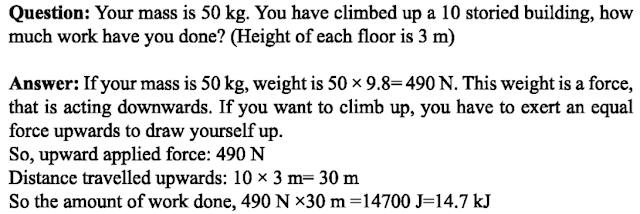Physics
Work, Power & Energy
Q.1. What is work?
Measure of energy transfer that occurs when an object is moved over a distance by an external force at least part of which is applied in the direction of the displacement.
If a force F is applied on any object and the object transverses a distance S during the application of force then, the amount of work W done by the force is:
W = FS
Unit of work = J
Dimension of work [ W] = ML² T¯²
Q.2. What is power?Ans: Power is the rate of doing work. If work W is done in time t, then power P is:P = W/tUnit of power: W (Watt)Dimention of power [ P] = ML² T¯³
Mechanical Energy: The energy that is obtained due to position shape and motion of the object is called mechanical energy. There are two forms of mechanical energy: These are -1. Kinetic2. Potential
Kinetic energy: The energy an object possesses by virtue of its notion. The energy of a body or a system with respect to the motion of the body or of the particles in the system.
KE = 1/2 mv²
Potential Energy: The energy an object possesses by virtue of its position in a field. gravitational, electromagnetic etc.
PE = mgh
Potential energy is the stored energy in an object or system becasue of its position or configuration. It cannot be transferred.
Q.3. What are the differences between kinetic and potential energy?1. Kinetic energy is the energy present in a body due to the property of its motion.1. Potential energy is the type of energy present in a body due to the property of its state.2. It can be easily transferred from one body to another.2. It is not transferable.3. The determining factors for kinetic energy are speed or velocity and mass.3. Here, the determining factors are height/distance and mass.4. Flowing water is one of the examples of kinetic energy.4. Water present at the top of a hill is an example of potential energy.
















